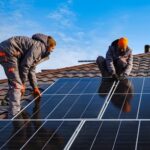
Cities are essential to the economy since they generate the most GDP. However, they use up about 75% of the world’s total energy and give off 50% to 60% of global greenhouse gases. The rising urban population also increases traffic congestions, pollution, and energy consumption level. As a result, the need to create sustainable cities has emerged, and people are coming together to find the most efficient solutions for the cities. Some of the ways to make smarter and greener cities include:
1. Add more green spaces
In the future, more people are more likely to move to urban centers. This means that there will be a massive production of carbon IV oxide and other pollutants. Cities should therefore consider adding trees and parks to clean the air. A green city will give people cleaner places to relax and reconnect with nature. More trees in the walking trails also reduce the amount of carbon IV oxide in the air.
Green spaces help prevent floods in case of heavy storms. The grass absorbs more water, which is a cheaper way to manage storms than the drainage system. Parks will also attract wildlife to create a balanced ecosystem.
You can plant trees and grass on the rooftop and throughout the streets in cities with limited spaces. Some cities are even adapting living walls. These are vertical gardens that help reduce pollution and create homes for a variety of birds.
Besides parks, people need to preserve agricultural lands in the urban centers. It will help shorten the supply chain and reduce greenhouse gas emissions while transporting food from rural to urban areas. The production of more fresh food in cities will improve access to nutritious food.
Note that there is a high demand for fast foods in urban areas due to their high availability and affordability. Such convenient food options require high processing, which leads to increased energy consumption. Unfortunately, this is a growing trend even in developing countries. City administrators can play a significant role in promoting healthier meal production by encouraging urban agriculture.
Even after promoting urban agriculture, administrators should develop ways to recover the excess food supplied and redistribute it to minimize waste. Although cities consume the highest percentage of the global food supply, much of this food becomes wasted. Such waste food may end up in landfills. When they decompose, they produce methane and other greenhouse gas.
2. Adapt smart city technology
Technology has become a part of nearly all parts of our lives. Innovative technology can help create sustainable cities. Businesses should adopt the remote sensing water technique, enabling smart irrigation, rainwater management, flood control, and pipe leakage detection to prevent water wastage.
Cities can also replace polluting conventional streetlights with LED options. Some of these smart street poles can even gather essential data like air quality and monitor traffic. For some people living in urban areas, it becomes a challenge to access a bank or even sign up for services like water and electricity.
Digital technologies like mobile banking and smart metering can enable people to pay bills from the comfort of the house. Transportation is the highest-ranked concern for most urban dwellers. You will find that most corporations are usually at the city center rather than in the metropolises. If commute times are long, it can lead to congestion and greenhouse gas emissions.
City planners should encourage an extension of such service providers in the city’s neighborhoods. Alternatively, you can promote mass transportation like metro systems and large buses rather than private cars. People within cities should also prioritize bicycles over cars.
3. Shift to solar energy
Cities should also consider using more solar energy to power buildings, industrial use, and transportation. As the urban population increase, so does the energy demand. Moving to renewable energy sources to cover the electricity needs will help reduce carbon footprints.
Note that the power of sunrays is infinite compared to fossil fuels. Hence, increased use of solar energy will prevent the depletion of natural resources. This will also lead to cleaner air, reduced climatic changes, improved living spaces, and better health in the long run.
If we want to create environmentally friendly cities for our future generations, we must reevaluate how these urban centers functions. This is only doable if we adopt clean energy plans, sustainable transport systems, and nature-based solutions that reduce environmental impacts.
- 3 Smart Ways Cities Can Become Eco-Friendly - July 8, 2021
- 3 Reasons Your Online Store Needs IP Targeting - July 7, 2021
- 3 Resources for Students Interested In Coding - July 2, 2021






